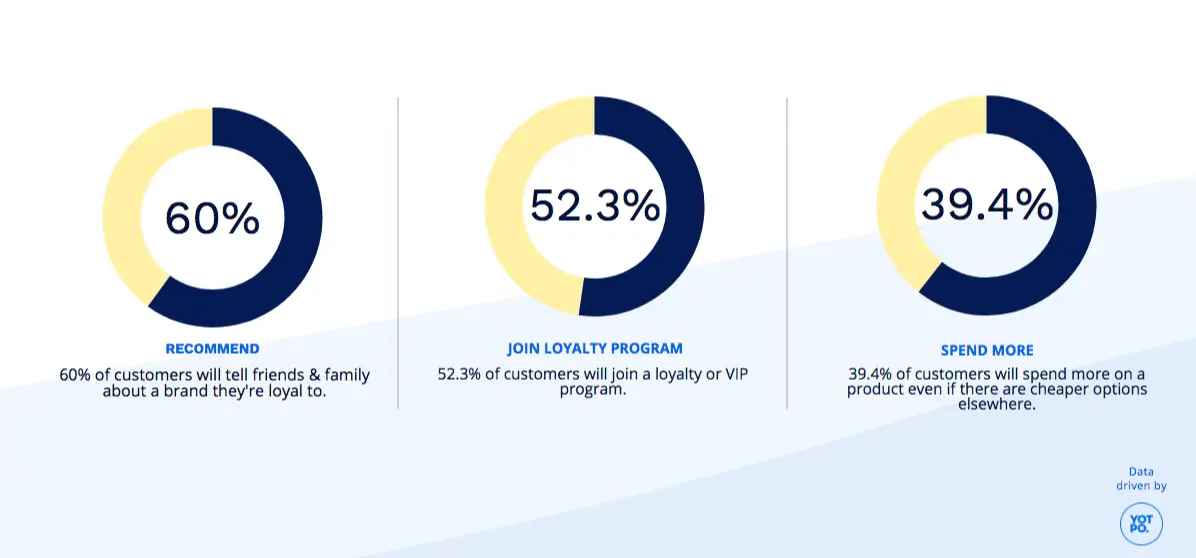The term “brand perception” is one of many “fluffy” branding terms.
It’s fairly self-explanatory on the face of it.
Your brand perception is the perception of a brand in the market… Simple.
It’s true that the term is self-explanatory and easy to understand, though few realise how the art of shaping that perception determines the success (or failure) of that brand.
In this article, we’ll break down what brand perception is, the important role it plays and what you can do to shape your brand’s perception in the mind of your audience during the customer experience.
What Is Brand Perception?

As I outlined in the intro, brand perception is easily defined as:
A Brand’s Perception In The Market
You could be forgiven for believing that the brand’s perception is, in fact, owned by the brand.
Even the structure of the statement is possessive.
The reality is however, the perception of your brand is owned not by the brand but by the consumers and the wider audience.
You see, although we can see physical collateral or digital platforms or even experience the brand physically through brand activation, none of these things is the brand itself.

They are simply expressions of the brand, which aim to influence the consumers’ perception of that brand when they experience it directly or indirectly.
In other words, the brand manifests in the mind of the audience, shaped by those experiences.
Even brand chiefs at powerhouse companies such as Coca-Cola and McDonald’s admit that
…Brand managers are losing the power to control the perception of their products through carefully crafted advertising campaigns. People increasingly discuss and disseminate branded content,
said Coke’s head of brand PR, Joan O’Connor.
To distill that even further;
The brand lives (and dies) in the mind of the audience through its perception.
Why Is Brand Perception Important?

Your customers are the reason your brand exists.
Without them, there is no brand or business behind it.
It’s fair to say then, that your customers matter… and so do their opinions of your brand.
The Impact Of Positive Perception

If a customer or prospect has a positive experience with your brand (whether through consumption or experience), your brand earns trust.
Earned trust dramatically increases the likelihood that they’ll choose (or come back to) your brand over your competitors.
They’re also far more likely to talk positively about your brand or demonstrate brand loyalty and advocacy.
In fact, according to Yotpo, 60% of customers will tell friends and family about a brand they’re loyal to.

This kind of brand advocacy (when your potential customers turn into marketers) is far more influential than any other form of marketing and is widely considered to be the holy grail of branding. Considering this, it’s easy to see how essential it is for brands to build positive customer relationships.
PRO Brand Strategy BluePrint
Build Brands Like A Pro Brand Strategist

The Impact Of Negative Perception

If a customer or prospect has a negative experience with your brand on the other hand trust is lost.
That’s why it’s always important to create a positive brand image that earns loyalty and helps acquire new customers.
Though it may take your brand multiple touchpoints and multiple positive experiences to generate any kind of influential impact, it may only take one negative experience to completely destroy a consumer relationship.
The reality is, we’re far more likely to share bad brand experiences with our friends and family than good brand experiences.
50% more likely according to marketingcharts.com
Explore Brand Strategy
Programs & Tools
Where Brand Perceptions Are Shaped

Considering that the brand lives in the mind of the audience through perceptions shaped by experiences….
The perception of a brand is everything.
The art of branding is not designing logos or even crafting messages or stories.
The art of branding is the art of shaping perceptions through the strategic tools a brand has at its disposal.
Brand Perception Is Shaped At Every Touch Point

When we experience a brand, we are experiencing strategically developed touchpoints throughout various customer journeys that are all designed to shape how we feel about that brand, which ultimately influences our overall brand perception.
These tools of brand expression include:
Positioning
Differentiation
Benefit & Value
Personality
Voice
Messaging
Stories
Emotion
Empathy
Logos
Typography
Colour
Imagery
Activation
Emails
Coupons
Advertisements
Articles
Webinars
Videos and more…
Essentially, every single touchpoint across every single channel or media, whether digital or physical, is another opportunity for a brand to influence the perception that lives in the mind of the audience and foster customer loyalty.
How To Influence Perceptions
With Strategy?

Each of the brand tools of influence mentioned in the previous section isn’t created through a shotgun strategy.
Each one is carefully developed through the brand strategy process, which in turn strategically shapes the individual touchpoints of the brand and the experiences of the audience through them.
Here are some of the most influential brand strategy elements that contribute to the overall brand experience.
Positioning Strategy

The position of the brand defines:
Why the brand is different to its competitors
And
The value of that difference to the customer
In essence, the positioning strategy establishes exactly what the audience should understand and remember about the brand as a priority, which influences the rest of the brand development and the overall communication strategy.
Brand Personality

Brand personality is becoming an increasingly important tool brands are leveraging to shape audiences’ perceptions.
Neuroscience has uncovered that, as humans, we make the majority of our decisions subconsciously through our reptilian complex and our emotional limbic system.
As humans, we connect with others based on characteristics and behavioural traits we’re either attracted to or not.
Brands making a conscious effort to understand their audience, their desires and their personality are at a distinct advantage when they use that understanding to shape brand communication through personality.
The more familiar a brand feels and the more attracted the audience is to the characteristics being displayed, the more likely the brand is to resonate.
Brand Messaging

One of the most influential tools at a brand’s disposal is the brand-messaging framework.
Though many understand the brand message to consist of a single “core message,” the reality is, with the indefinite touchpoints of modern brands, a comprehensive brand-messaging framework, or template, is required.
This framework should outline a collection of key messages, which are developed to shape the audience’s understanding of the brand.
These individual key messages are then used to influence specific touchpoint messages across every platform.
Emotional Storytelling

As humans, we all have an innate attraction to stories as they’ve been used to transfer information from one generation to the next over millions of years.
We gravitate towards stories because our instinct tells us that there is a reward of knowledge at the conclusion.
This gravitational attraction towards story and our emotional limbic system decision-making bias make for a potent combination.
Brands that can wrap their messages up in emotional storytelling can leverage our human instincts to attract eyes and ears.
Authenticity

Authenticity is the hallmark of modern brands. It aims to connect with audiences through human emotions.
Since the shift of consumer power from brands to consumers on the back of the digital revolution, brands have evolved into human personas.
The days of one-way broadcast communication are gone.
Today, brands must communicate on the digital front lines, and consumers are less tolerant of brands talking… well, let’s call it bulldust.
Honesty is a key ingredient of modern brand communication and is measured by instinct.
Visual Identity

The development of the brand personality defines the characteristics that the brand should use throughout its messaging.
While the messaging framework has an opportunity to deliver those characteristics through language and tone, the visual identity can bring them to life visually.
As the old adage goes:
You never get a second chance to make a first impression.
We all know that a brand is not a logo, though the visual identity, as a whole, still has an important role to play.
If the strategic characteristics are displayed visually, the brand strategy can begin shaping perceptions within milliseconds of first contact and beyond.
How To Measure Brand Perception?

Brand equity is the premium on the value a brand offers a business.
In other words it’s the intangible value attributed to the brand in isolation from the business.
Growing brand equity is, in essence, growing the brand, and in order to measure that equity, brand perception must be measured.
Because your brand perception lives in the mind of your audience, that’s where you must go to measure it.
Audience Outreach

Most brands begin building an audience from day one across multiple platforms.
A social media following across multiple platforms and an active email list provide the brand with an outreach tool.
Although social posts asking for positives and negatives might result in your brand hanging out its dirty laundry in public, private messages and email offer a great way to get the lowdown from the horse’s mouth.
Customer Feedback

Customer feedback is a direct reflection of how your target audience perceives your brand.
Remember that positive public perception has a direct effect on key metrics like conversions and revenue.
In fact, a great customer experience can cultivate positive word of mouth which can boost your bottom line while saving your brand money on marketing.
Investing in market research also helps unlock customer insights to help improve customer satisfaction.
Reach out with a brand perception survey or host focus groups and ask the people that matter.
Let the respondents offer key insights into how they perceive your brand identity, and what you can do to make it more positive.
Social Monitoring

Social media has become the modern-day Piazza where people hang out and share their opinions and experiences.
Social media platforms such asLinkedIn, Twitter, Facebook, and Instagram have become central to effective marketing strategies for brands looking to promote their products and services. All you have to do is evaluate your target demographics and the functionality you need from a channel to find the best-suited channel.
Social media provides the perfect setting for companies to improve brand awareness, build brand equity, and connect their brand name with credibility, value, and solutions.
Unlike the days of old when eavesdropping in on a conversation might get you a bad rep or a bloody nose, today, brands can simply search discussions for mentions of their brand to get a temperature of the overall sentiment.
There are plenty of social media monitoring tools today, which all offer the ability to engage in social listening and gain insights into a company’s brand perception through social media conversations.
Review Sites

Whether we have a good or bad experience with a brand, we have plenty of digital platforms and forums available to us to spread the good, the bad or the indifferent word.
Keeping an eye on online reviews and different review sites is an excellent and way to get an overall gauge of brand perception in the market.
It’s also a go-to for consumers who are in the consideration phase to get their own perceptions confirmed (or readjusted).
Over To You
The branding industry has many terms that are used interchangeably and can dilute the importance of others.
Brand perception is a key branding term you need to take note of as a brand builder because this is the very thing the brand you’re building aims to shape.
If the brand is developed with a crystal clear understanding of who the audience is and a clearly defined position, it can develop a communication strategy with a definitive plan to create positive brand perceptions.
At the end of the day, your customers are your most important stakeholders.
Do you consider the perception you want to create in the mind of your audience as you build your brands?
I’d love to hear your brand perception experiences or challenges in the comments below.
On-Demand Digital Program
Brand Master Secrets
Make the transition from hired-gun to highly valued brand strategist in less than 30 days. The systems, frameworks and tools inside this comprehensive program are all you need to level up.










I have been checking out a few of your articles and i must say clever stuff. I will surely bookmark your site. Jeane Elihu Beryl
This piece of writing gives clear idea for the new visitors of
blogging, that genuinely how to do running
a blog.
you are best, very nicee blog yoour amazing site.
yoou are besst, very nicee blog your amazing site.
????????????????
yoou areee best, very nicee blog your amazinng site.
Great to hear thank you ????
your articles are very good and your blog site iss really good
your articles are very good and your blog site is reaally good
Thank you
Hmm is anyone else experiencing problems with the images on this blog loading? I’m trying to determine if its a problem on my end or if it’s the blog. Any feed-back would be greatly appreciated.
fixed
i love your content. thank you
thank you
Nice writtern. Thank you bro
Go to our blog page there are many more topics that can give you insight